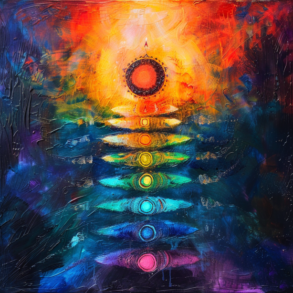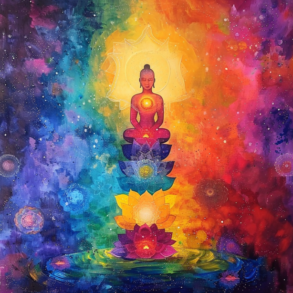Chakra Healing
Have you ever wondered about the difference between Reiki and Chakra Healing? Well, both of these practices focus on energy healing and promoting balance within the body and mind. However, there are some subtle distinctions between the two. Chakra healing primarily works with the seven main energy centers in the body, aiming to clear blockages and restore harmony. On the other hand, Reiki is an energy healing technique that involves the transfer of universal life force energy through a practitioner’s hands to the recipient, promoting relaxation and overall well-being. While both practices can complement each other and offer numerous benefits, it’s crucial to understand their unique approaches and consult a qualified practitioner for personalized guidance.
Main Differences
Different Approaches
Chakra healing and Reiki are two distinct approaches to energy healing. While both focus on promoting balance and well-being, they have unique perspectives and techniques.
Chakra healing takes a holistic approach, focusing on balancing the seven main chakras located along the spine. These chakras are believed to be energy centers that correspond to different aspects of our physical, emotional, and spiritual selves. Chakra healing aims to identify and address imbalances or blockages in these energy centers to promote overall harmony and well-being.
On the other hand, Reiki is a Japanese energy healing technique that channels universal life force energy through the practitioner’s hands to the recipient. Reiki practitioners believe that this universal energy can help activate the body’s natural healing processes and restore balance on physical, emotional, and spiritual levels.
Focus of Healing
Chakra healing primarily focuses on balancing and harmonizing the energy flow within the chakra system. Imbalances or blockages in these energy centers can lead to physical ailments or emotional disturbances. By addressing these imbalances, chakra healing aims to promote overall wellness and a sense of harmony within the body and mind.
Reiki, on the other hand, focuses on channeling universal life force energy to promote healing. The energy flows through the practitioner’s hands and is directed to the recipient. Reiki aims to activate the body’s natural healing abilities, reduce stress, and promote relaxation and overall well-being.
Techniques Used
Chakra healing incorporates various techniques to balance and harmonize the chakras. These techniques may include meditation, visualization, affirmations, yoga, sound therapy, crystals, aromatherapy, and energy work such as Reiki. Each technique is chosen based on its ability to bring balance and healing to the specific chakra being addressed.
Reiki, as a specific energy healing modality, primarily uses the laying-on of hands technique. The practitioner places their hands on or near specific areas of the recipient’s body, directing the universal life force energy towards those areas. This gentle touch aims to channel the energy to where it is needed most, promoting relaxation, stress reduction, and overall healing.
Training and Certification
To become a chakra healing practitioner, extensive training and knowledge of the chakra system are required. Practitioners may undergo courses, workshops, or certifications to learn about the functions and characteristics of each chakra, as well as various healing techniques and practices. However, specific certifications or regulatory bodies for chakra healing may vary.
In contrast, Reiki training typically involves three levels of attunement or initiation. These levels, often referred to as Reiki I, Reiki II, and Reiki Master, progressively deepen the practitioner’s connection to the universal life force energy and expand their healing abilities. Reiki training is typically standardized, and practitioners can obtain certifications through reputable Reiki organizations.
Application
Chakra healing can be applied in various ways depending on the specific needs and imbalances of the individual. Practitioners may focus on specific chakras or work on balancing the entire chakra system. Chakra healing techniques can be practiced individually, through guided sessions, or incorporated into other holistic practices such as yoga or meditation.
Reiki can also be applied in different ways, including individual sessions, group sessions, or distant healing. During a Reiki session, recipients remain fully clothed and typically lie down on a treatment table or sit in a chair. The practitioner places their hands on or near the recipient’s body, allowing the energy to flow and promote healing.
Targeted Energy
Chakra healing’s energy focus is on the seven main chakras and their corresponding energy centers. The goal is to identify and address imbalances or blockages specific to each chakra. By balancing these energy centers, overall energetic harmony and well-being can be achieved.
Reiki focuses on channeling universal life force energy, which is believed to flow through all living beings. The practitioner acts as a conduit for this energy and directs it to areas where it is needed most. Reiki energy is not specific to chakras but aims to promote overall balance and healing on physical, emotional, and spiritual levels.

Level of Involvement
In chakra healing, the individual seeking healing is usually an active participant. They may engage in various self-care practices such as meditation, affirmations, or yoga to restore balance to their chakra system. Chakra healing sessions with a practitioner may involve guidance, energy work, and recommendations for continued self-care.
In Reiki, the recipient plays a more passive role and receives the healing energy directly from the practitioner. The recipient’s involvement is primarily to be open and receptive to the energy, allowing it to work on a deep level. However, Reiki can also empower individuals to learn and practice self-Reiki, allowing them to take an active role in their healing process.
Practitioner’s Role
A chakra healing practitioner’s role is to facilitate the balancing and healing of the individual’s chakra system. They may assess the energy flow in each chakra, identify imbalances or blockages, and use various techniques to restore balance. The practitioner may also guide the individual in understanding their chakras and provide lifestyle recommendations to support ongoing healing.
In Reiki, the practitioner acts as a channel for the universal life force energy. Their role is to transmit this energy to the recipient, allowing it to flow and promote healing. The practitioner may also use intuitive guidance to identify areas of energetic imbalance and offer support and comfort during the session.

Philosophy and Beliefs
Chakra healing is based on the belief that imbalances or blockages in the chakras can lead to physical, emotional, and spiritual disturbances. It draws upon the understanding that by addressing and balancing these energy centers, overall wellness and harmony can be achieved. Chakra healing views the body and mind as interconnected, with energy flowing through the chakras playing a vital role in maintaining health and well-being.
Reiki is based on the belief in the existence of a universal life force energy that flows through all living beings. Practitioners believe that this energy can be accessed and channeled to promote healing and well-being. Reiki has a non-denominational and non-religious philosophy, making it accessible to individuals of different spiritual beliefs or backgrounds.
Effectiveness and Results
The effectiveness of chakra healing and Reiki may vary from person to person. Both approaches can promote relaxation, stress reduction, and a sense of overall well-being. Chakra healing aims to address specific imbalances in the chakra system, which may lead to improvements in physical health, emotional well-being, and spiritual growth.
Reiki, as an energy healing modality, is known for its ability to induce deep relaxation, reduce stress, and support the body’s natural healing processes. It can help alleviate physical ailments, ease emotional distress, and promote a sense of peace and balance.
The results of chakra healing and Reiki can be highly individualized, depending on the specific imbalances or concerns of the individual. Some individuals may experience immediate relief, while others may notice gradual improvements over time. It is important to approach these practices with an open mind and a willingness to engage in self-care and personal growth.
In conclusion, both chakra healing and Reiki offer unique approaches to energy healing, focusing on promoting balance and well-being. Whether you choose to address imbalances in your chakra system or receive healing energy through Reiki, both practices have the potential to support your physical, emotional, and spiritual journey towards greater harmony and wellness. Remember to consult with qualified practitioners and explore what resonates with you on your path of healing and self-discovery.

